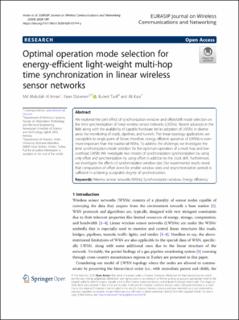| dc.contributor.author | Imran, Md Abdullah Al | |
| dc.contributor.author | Dalveren, Yaser | |
| dc.contributor.author | Tavli, Bulent | |
| dc.contributor.author | Kara, Ali | |
| dc.date.accessioned | 2020-06-05T08:54:06Z | |
| dc.date.available | 2020-06-05T08:54:06Z | |
| dc.date.created | 2020-06-02T22:36:34Z | |
| dc.date.issued | 2020 | |
| dc.identifier.citation | EURASIP Journal on Wireless Communications and Networking. 2020, 109 | en_US |
| dc.identifier.issn | 1687-1472 | |
| dc.identifier.uri | https://hdl.handle.net/11250/2656920 | |
| dc.description.abstract | We explored the joint effect of synchronization window and offset/drift mode selection on the time synchronization of linear wireless sensor networks (LWSNs). Recent advances in the field along with the availability of capable hardware led to adoption of LWSNs in diverse areas like monitoring of roads, pipelines, and tunnels. The linear topology applications are susceptible to single point of failure; therefore, energy efficient operation of LWSNs is even more important than the traditional WSNs. To address the challenge, we investigate the time synchronization mode selection for the optimum operation of a multi-hop and low-overhead LWSN. We investigate two modes of synchronization: synchronization by using only offset and synchronization by using offset in addition to the clock drift. Furthermore, we investigate the effects of synchronization window size. Our experimental results reveal that computation of offset alone for smaller window sizes and resynchronization periods is sufficient in achieving acceptable degree of synchronization. | en_US |
| dc.language.iso | eng | en_US |
| dc.publisher | Springer Verlag | en_US |
| dc.rights | Navngivelse 4.0 Internasjonal | * |
| dc.rights.uri | http://creativecommons.org/licenses/by/4.0/deed.no | * |
| dc.title | Optimal Operation Mode Selection for Energy-efficient Light-weight Multi-hop Time Synchronization in Linear Wireless Sensor Networks | en_US |
| dc.type | Peer reviewed | en_US |
| dc.type | Journal article | en_US |
| dc.description.version | publishedVersion | en_US |
| dc.source.volume | 109 | en_US |
| dc.source.journal | EURASIP Journal on Wireless Communications and Networking | en_US |
| dc.identifier.doi | 10.1186/s13638-020-01744-y | |
| dc.identifier.cristin | 1813559 | |
| dc.description.localcode | Open Access This article is licensed under a Creative Commons Attribution 4.0 International License, which permits use, sharing, adaptation, distribution and reproduction in any medium or format, as long as you give appropriate credit to the original author(s) and the source, provide a link to the Creative Commons licence, and indicate if changes were made. The images or other third party material in this article are included in the article's Creative Commons licence, unless indicated otherwise in a credit line to the material. If material is not included in the article's Creative Commons licence and your intended use is not permitted by statutory regulation or exceeds the permitted use, you will need to obtain permission directly from the copyright holder. To view a copy of this licence, visit http://creativecommons.org/licenses/by/4.0/. | en_US |
| cristin.ispublished | true | |
| cristin.fulltext | original | |
| cristin.qualitycode | 1 | |

